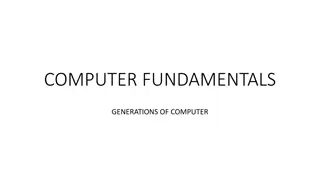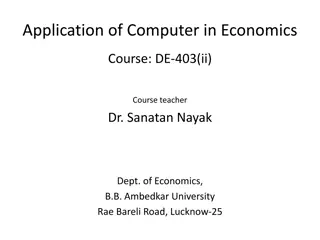Evolution of Computer Generations: From 1st to 5th
The development of computers is categorized into generations based on technological advancements. Starting from the First Generation (1946-1959) with vacuum tubes to the Fifth Generation known for artificial intelligence, each era brought significant changes in computer capabilities. First-generation computers like ENIAC were large and used machine language, paving the way for faster calculations despite limitations in size and cooling requirements.
Download Presentation

Please find below an Image/Link to download the presentation.
The content on the website is provided AS IS for your information and personal use only. It may not be sold, licensed, or shared on other websites without obtaining consent from the author. Download presentation by click this link. If you encounter any issues during the download, it is possible that the publisher has removed the file from their server.
E N D
Presentation Transcript
Generations of Computer: 1st to 5th Nowadays, the computer is one of the essential parts of our day to day activities. Computers are so smart that they can also do many tasks automatically according to the data given to them. However, computers were not like this before. There were constant developments and innovations in computer technology that made computers so powerful and useful. All such developments are divided into different generations of computers.
What are the generations of computers? Generations of computers are mainly divided according to the development of computer technology. Each generation defines the major technological developments on which computer systems were/are based. In the early days of development, the 'generation of computers' was intended solely to illustrate the differences between hardware technologies. However, nowadays the term is the conclusion of both hardware and software changes involved in the path of computer development. In particular, the term 'generation' refers to development that changes the way computers work. Moreover, frequent improvements were made to make computer devices more compact in size, cheaper in price, more powerful and smarter, etc.
What are the five generations of computers? First Generation (1946 1959) This is the earliest generation of computers, known as the first generation of computers. The first generation period is considered from 1946 to 1959. During the first generation, computers were developed using vacuum tubes as the core technology. First-generation computers used the machine language, the lowest-level programming language so that it could be easily processed and understood by computers.
ENIAC, short for Electronic Numeric Integrated and Calculator, is the most popular example of the first generation computer. Other examples include UNIVAC, EDVAC, EDSAC, IBM-650, IBM-701, Manchester Mark 1, Mark 2, Mark 3, etc. Advantages of the First Generation Computers Vacuum tubes were used in first-generation computers, and the generation helped introduce computer devices. Due to the use of machine languages, computers of this generation were faster as early development. Computers were able to perform calculations in milliseconds.
Disadvantages of the First Generation Computers First-generation computers were very large and could also cover an entire room. Computers of this generation generated too much heat and required a large cooling system. Storage capacity in computers was very low in this generation.


























